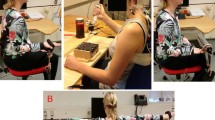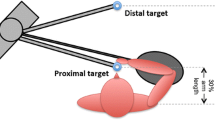Abstract
This study investigates the changes in mechanomyographic (MMG) topographical maps of the upper trapezius muscle during short and sustained isometric contractions until task failure. MMG signals were detected over the dominant upper trapezius muscle of 12 volunteers using an unstructured grid of 12 accelerometers. The subjects performed isometric shoulder elevation at (1) maximal voluntary contraction (100% MVC), (2) 10–20–40–60–80–100% MVC for 10 s and (3) 20% MVC until task failure. Maps of absolute and normalised average rectified value (ARV) and mean power frequency (MNF) were obtained from the two-dimensional MMG recordings. Entropy (measure of heterogeneity of maps) of the MMG ARV and MNF distributions, changes over time of ARV and MNF, and the ratio between ARV at the task failure and at 100% MVC (activation ratio) were analysed in relation to the time to task failure. For the short duration and sustained contractions, MMG ARV and MNF depended on accelerometer location (P < 0.001) while normalised values did not. The activation ratio was positively correlated with the time to task failure (R 2 = 0.36, P < 0.05). Lower ARV entropy values (P < 0.05), greater MMG ARV increase during the endurance test (P < 0.001) and higher values of ARV activation ratio (P < 0.001) were observed in the subjects with longer time to task failure. The results demonstrate an association between time to task failure and MMG activation ratio and ARV entropy, which indicates that spatial variations in MMG activity and its changes over time underlie functional mechanisms for the maintenance of force during fatiguing contractions.





Similar content being viewed by others
References
Akataki K, Mita K, Watakabe M, Itoh K (2001) Mechanomyogram and force relationship during voluntary isometric ramp contractions of the biceps brachii muscle. Eur J Appl Physiol 84:19–25
Barry DT (1987) Acoustic signals from frog skeletal muscle. Biophys J 51:769–773
Bigland-Ritchie B, Johansson RS, Lippold OCJ, Smith S, Woods JJ (1981) Conduction velocity and EMG power spectrum changes in fatigue of sustained maximal efforts. J Appl Physiol 51:1300–1305
Cescon C, Farina D, Gobbo M, Merletti R, Orizio C (2004) Effect of accelerometer location on mechanomyogram variables during voluntary, constant-force contractions in three human muscles. Med Biol Eng Comput 42:121–127
Danoff JV (1986) EMG normalization. Phys Ther 66:270
De Luca CJ (1984) Myoelectrical manifestations of localized muscle fatigue in humans. Crit Rev Biomed Eng 11:251–279
DeLuca CJ (1997) The use of surface electromyography in biomechanics. J Appl Biomech 13:135–163
DeLuca CJ, Foley PJ, Erim Z (1996) Motor unit control properties in constant-force isometric contractions. J Neurophysiol 76:1503–1516
Fallentin N, Jorgensen K, Simonsen EB (1993) Motor unit recruitment during prolonged isometric contractions. Eur J Appl Physiol 67:335–341
Farina D, Leclerc F, Arendt-Nielsen L, Butteli O, Madeleine P (2006) The change in the spatial distribution of upper trapezius muscle activity is correlated to endurance time in static contraction. J Electromyogr Kinesiol. doi:10.1016/j.jelekin.2006.08.005
Frangioni JV, Kwan-Gett TS, Dobrunz LE, McMahon TA (1987) The mechanism of low-frequency sound production in muscle. Biophys J 51:775–783
Gobbo M, Madeleine P, Cescon C, Orizio C, Farina D (2006) Influence of instantaneous discharge rate on motor unit contribution to mechanomyogram. Proceedings of the XVI Congress of the International Society of Electromyography and Kinesiology, Torino, p 91
Hanson J, Persson A (1971) Changes in the action potential and contraction of isolated frog muscle after repetitive stimulation. Acta Physiol Scand 81:340–348
Holtermann A, Roeleveld K (2006) EMG amplitude distribution changes over the upper trapezius muscle are similar in sustained and ramp contractions. Acta Physiol (Oxf) 186:159–168
Jaskolska A, Madeleine P, Jaskolski A, Kisiel-Sajewicz K, Arendt-Nielsen L (2007) A comparison between mechanomyographic condenser microphone and accelerometer measurements during submaximal isometric, concentric and eccentric contractions. J Electromyogr Kinesiol 17:336–347
Jensen C, Westgaard RH (1997) Functional subdivision of the upper trapezius muscle during low-level activation. Eur J Appl Physiol 76:335–339
Kawczynski A, Nie H, Jaskolska A, Jaskolski A, Arendt-Nielsen L, Madeleine P (2007) Mechanomyography and electromyography during and after fatiguing shoulder eccentric contractions in males and females. Scand J Med Sci Sports 17:172–179
Kleine BU, Schumann NP, Stegeman DF, Scholle HC (2000) Surface EMG mapping of the human trapezius muscle: the topography of monopolar and bipolar surface EMG amplitude and spectrum parameters at varied forces and in fatigue. Clin Neurophysiol 111:686–693
Kouzaki M, Shinohara M (2006) The frequency of alternate muscle activity is associated with the attenuation in muscle fatigue. J Appl Physiol 101:715–720
Madeleine P, Farina D, Merletti R, Arendt-Nielsen L (2002) Upper trapezius muscle mechanomyographic and electromyographic activity in humans during low force fatiguing and non-fatiguing contractions. Eur J Appl Physiol 87:327–336
Madeleine P, Cescon C, Farina D (2006a) Spatial and force dependency of mechanomyographic signal features. J Neurosci Methods 158:89–99
Madeleine P, Ge HY, Jaskolska A, Farina D, Jaskolski A, Arendt-Nielsen L (2006b) Characterization of the mechanomyographic signals recorded with accelerometer and microphone during sustained contraction. Med Biol Eng Comput 44:290–297
Madeleine P, Nie H, Arendt-Nielsen L (2006c) Dynamic shoulder dynamometry: a way to develop delay onset muscle soreness in shoulder muscles. J Biomech 39:184–188
Madeleine P, Mathiassen SE, Arendt-Nielsen L (2007a) Changes in motor variability associated with experimental and chronic neck-shoulder pain during a standardized repetitive arm movement (submitted)
Madeleine P, Tuker K, Arendt-Nielsen L, Farina D (2007b) Heterogeneous mechanomyographic absolute activation of paraspinal muscles assessed by a two-dimensional array during short and sustained contractions. J Biomech 40:2663–2671
Mamaghani NK, Shimomura Y, Iwanaga K, Katsuura T (2001) Changes in surface EMG and acoustic myogram parameters during static fatiguing contractions until exhaustion: influence of elbow joint angles. J Physiol Anthropol Appl Human Sci 20:131–140
Mamaghani NK, Shimomura Y, Iwanaga K, Katsuura T (2002) Mechanomyogram and electromyogram responses of upper limb during sustained isometric fatigue with varying shoulder and elbow postures. J Physiol Anthropol Appl Human Sci 21:29–43
Mathiassen SE, Winkel J, Hägg GM (1995) Normalisation of surface EMG amplitude from the upper trapezius muscle in ergonomic studies: a review. J Electromyogr Kinesiol 5:197–226
Maton B, Gamet D (1989) The fatigability of two agonistic muscles in human isometric voluntary submaximal contraction: an EMG study. II. Motor unit firing rate and recruitment. Eur J Appl Physiol 58:369–374
Moseley GL, Hodges PW (2006) Reduced variability of postural strategy prevents normalization of motor changes induced by back pain: a risk factor for chronic trouble? Behav Neurosci 120:474–476
Nordander C, Balogh I, Mathissen SE, Ohlsson K, Unge J, Skerfving S, Hansson GA (2004) Precision of measurements of physical workload during standardised manual handling. Part I: surface electromyography of m-trapezius, m-infraspinatus and the forearm extensors J Electromyogr Kinesiol 14:443–454
Orizio C (1993) Muscle sound: bases for the introduction of a mechanomyographic signal in muscle studies. Crit Rev Biomed Eng 21:201–243
Orizio C, Liberati D, Locatelli C, De Grandis D, Veicsteinas A (1996) Surface mechanomyogram reflects muscle fibres twitches summation. J Biomech 29:475–481
Orizio C, Gobbo M, Diemont B, Esposito F, Veicsteinas A (2003) The surface mechanomyogram as a tool to describe the influence of fatigue on biceps brachii motor unit activation strategy: historical basis and novel evidence. Eur J Appl Physiol 90:326–336
Ouamer M, Boiteux M, Petitjean M, Travens L, Sales A (1999) Acoustic myography during voluntary isometric contraction reveals non-propagative lateral vibration. J Biomech 32:1279–1285
Shinohara M, Søgaard K (2006) Mechanomyography for studying force fluctuations and muscle fatigue. Exerc Sport Sci Rev 34:59–64
Staudenmann D, Kingma I, Stegeman DF, van Dieën JH (2005) Towards optimal multi-channel EMG electrode configurations in muscle force estimation: a high density EMG study. J Electromyogr Kinesiol 15:1–11
van Dieën JH, Vrielink HHEO, Housheer AF, Lotters FBJ, Toussaint HM (1993) Trunk extensor endurance and its relationship to electromyogram parameters. Eur J Appl Physiol 66:388–396
van Dieën JH, Selen LPJ, Cholewicki J (2003) Trunk muscle activation in low-back pain patients, an analysis of the literature. J Electromyogr and Kinesiol 13:333–351
Welch PD (1967) Use of fast Fourier transform for estimation of power spectra—a method based on time averaging over short modified periodograms. IEEE Trans Audio Electroacoust AU15:70–73
Westad C, Westgaard RH, De Luca CJ (2003) Motor unit recruitment and derecruitment induced by brief increase in contraction amplitude of the human trapezius muscle. J Physiol (Lond) 552:645–656
Westad C, Mork PJ, Westgaard RH (2004) Firing patterns of low-threshold trapezius motor units in feedback-controlled contractions and vocational motor activities. Exp Brain Res 158:465–473
Westgaard RH, De Luca CJ (2001a) Motor control of low-threshold motor units in the human trapezius muscle. J Neurophysiol 85:1777–1781
Westgaard RH, De Luca CJ (2001b) Motor unit substitution in long-duration contractions of the human trapezius muscle. J Neurophysiol 82:501–504
Yoshitake Y, Moritani T (1999) The muscle sound properties of different muscle fiber types during voluntary and electrically induced contractions. J Electromyogr Kinesiol 9:209–217
Acknowledgments
This work was supported by the Danish Health and Safety Research Fund (FINALE project). The system for two-dimensional MMG detection has been developed at the Laboratory for Neuromuscular System Engineering (LISiN), Torino, Italy. The authors are sincerely grateful to R. Antonelli, A. Binderup, A. Garg, A. Khan, F. Naddeo and A. Paiola for their contribution to data collection.
Author information
Authors and Affiliations
Corresponding author
Rights and permissions
About this article
Cite this article
Madeleine, P., Farina, D. Time to task failure in shoulder elevation is associated to increase in amplitude and to spatial heterogeneity of upper trapezius mechanomyographic signals. Eur J Appl Physiol 102, 325–333 (2008). https://doi.org/10.1007/s00421-007-0589-2
Accepted:
Published:
Issue Date:
DOI: https://doi.org/10.1007/s00421-007-0589-2




